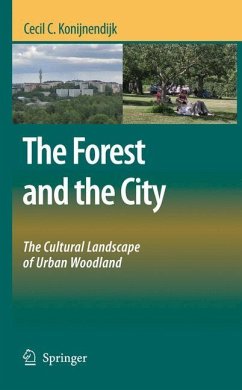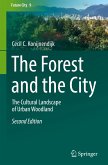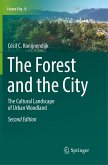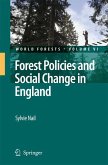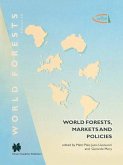Amsterdamse Bos, Bois de Boulogne, Epping Forest, Grunewald, Zoniënwoud; throughout history, cities in Europe and elsewhere have developed close relationships with nearby woodland areas. In some cases, cities have even developed - and in some cases are promoting - a distinct 'forest identity'. This book introduces the rich heritage of these city forests as cultural landscapes, and shows that cities and forests can be mutually beneficial.
Essential reading for students and researchers interested in urban sustainability and urban forestry, this book also has much wider appeal. For with city forests playing an increasingly important role in local government sustainability programs, it provides an important reference for those involved in urban planning and decision making, public affairs and administration, and even public health.
From providers of livelihoods to healthy recreational environments, and from places of inspiration and learning to a source of conflict,the book presents examples of city forests from around the world. These cases clearly illustrate how the social and cultural development of towns and forests has often gone hand in hand. They also reveal how better understanding of city forests as distinct cultural and social phenomena can help to strengthen synergies both between cities and forests, and between urban society and nature.
Essential reading for students and researchers interested in urban sustainability and urban forestry, this book also has much wider appeal. For with city forests playing an increasingly important role in local government sustainability programs, it provides an important reference for those involved in urban planning and decision making, public affairs and administration, and even public health.
From providers of livelihoods to healthy recreational environments, and from places of inspiration and learning to a source of conflict,the book presents examples of city forests from around the world. These cases clearly illustrate how the social and cultural development of towns and forests has often gone hand in hand. They also reveal how better understanding of city forests as distinct cultural and social phenomena can help to strengthen synergies both between cities and forests, and between urban society and nature.
From the reviews:
"This book offers a detailed ... exploration of the relationship between forest and cities. ... Summing Up: Recommended. Public and professional libraries." (S. Hammer, Choice, Vol. 46 (5), January, 2009)
"The book looks at city forests primarily from a cultural and social perspective but also ... provide an important reference for those involved in urban planning and decision marking, public affairs and administration, and even public health. ... the book is well-researched and makes a significant contribution to the urban forestry sector and a fundamental reading for students and researchers interested in urban sustainability and urban forestry, but it's also essential for those involved in the national and local government sustainability programs." (Francesco Ferrini, Advances in Horticultural Science, Vol. 23 (1), 2009)
"As its title suggests, this book explores the relationships between cities and forests. ... throughout the book there are numerous references to non-European city-forest relations, particularly those in North America. ... this is a timely volume. It integrates narrative, historical and academic analysis, and is concisely written and well illustrated. It is an enjoyable read and a welcome addition to the usual academic and forestry literature." (Lawrence Kitchen, Journal of Environmental Policy & Planning, Vol. 12 (1), March, 2010)
"A city forest provides products, a meeting place, an identity, and a link between people and their environment. This is the perspective from which the book is written; it thus approaches city forests primarily from a cultural and social perspective. ... I would recommended this book to those who are interested in learning more about the social and cultural role that city forests have ... . The book is well focused, engagingly written, and, with the many clarifying examples and photographs, pleasant to read." (J. WillemijnWeijschede-van der Straaten, Journal of Housing and the Built Environment, Vol. 25, March, 2010)
"This book offers a detailed ... exploration of the relationship between forest and cities. ... Summing Up: Recommended. Public and professional libraries." (S. Hammer, Choice, Vol. 46 (5), January, 2009)
"The book looks at city forests primarily from a cultural and social perspective but also ... provide an important reference for those involved in urban planning and decision marking, public affairs and administration, and even public health. ... the book is well-researched and makes a significant contribution to the urban forestry sector and a fundamental reading for students and researchers interested in urban sustainability and urban forestry, but it's also essential for those involved in the national and local government sustainability programs." (Francesco Ferrini, Advances in Horticultural Science, Vol. 23 (1), 2009)
"As its title suggests, this book explores the relationships between cities and forests. ... throughout the book there are numerous references to non-European city-forest relations, particularly those in North America. ... this is a timely volume. It integrates narrative, historical and academic analysis, and is concisely written and well illustrated. It is an enjoyable read and a welcome addition to the usual academic and forestry literature." (Lawrence Kitchen, Journal of Environmental Policy & Planning, Vol. 12 (1), March, 2010)
"A city forest provides products, a meeting place, an identity, and a link between people and their environment. This is the perspective from which the book is written; it thus approaches city forests primarily from a cultural and social perspective. ... I would recommended this book to those who are interested in learning more about the social and cultural role that city forests have ... . The book is well focused, engagingly written, and, with the many clarifying examples and photographs, pleasant to read." (J. WillemijnWeijschede-van der Straaten, Journal of Housing and the Built Environment, Vol. 25, March, 2010)

